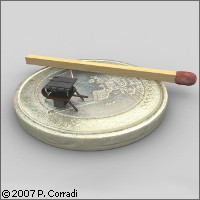Life on Mars? It may come faster for robots!
Demographers estimate that 6.72 billion people currently inhabit Earth and the number is expected to grow to 9 billion over the next 35 years or so. With scientists having succeeded in finding water and Earth-like soil on Mars, some wonder whether the Red Planet could be colonised in the future. But the I-SWARM project maintains that the first 'creatures' likely to inhabit Mars will be swarms of tiny robots. Supported by the EU with funding totalling EUR 4.4 million, this Integrated Project created a group of robots that can carry out various tasks and explorations. 'Small robots that are able to work together could explore the planet,' Marc Szymanski from the University of Karlsruhe in Germany told ICT Results. 'We now know there is water and dust so all they would need is some sort of glue to start building structures, such as homes for human scientists.' The project partners developed the centimetre-scale robots and made significant progress in creating swarms of ant-sized micro-bots, they said. These robots are autonomous and are able to jointly carry out tasks that real insects can handle, including building nests and foraging for food. The research team said the exploration and colonisation of planets are just some of the activities that robots have the potential to carry out. According to them, these robots could fine-tune their work so as to deal with the task at hand and even adapt to a changing environment. 'Robot swarms are particularly useful in situations where you need high redundancy,' said Szymanski, a robotics researcher at the university. 'If one robot malfunctions or is damaged it does not cause the mission to fail because another robot simply steps in to fill its place.' The potential applications for robotics technology are huge. Space and deep water are not the only environments that could benefit from this technology. These tiny robots could play a pivotal role in the medical world, in carrying out tests and applying treatments inside the human body for example, the researchers said. While getting these robots off the ground to be used by real people for real situations is not yet possible, the project partners have made major headway in developing robots that come close to resembling a programmable ant. These robots generated by I-SWARM have the capacity to communicate with each other and sense their environment, which is exactly what real ants do. The result is a kind of collective perception, the researchers noted. Infrared is used by I-SWARM's robots to make communication possible. Each robot signals to another that is near, and it doesn't stop until the entire swarm is informed. Any barrier that impedes this communication effectively forces the ants to signal others to surround it and get it out of the way. A group of I-SWARM robots is called 'Jasmine', and is about the size of a two-euro coin and runs on battery power. The tiniest robots are just three millimetres in length and draw power from a minute solar cell. 'Power is a big issue. The more complex the task, the more energy is required,' the researcher said. 'A robot that needs to lift something [uses] powerful motors and these need lots of energy.' The researchers are now working on developing swarms of robots that can reconfigure themselves and assemble autonomously into larger robots as part of the EU-funded projects Symbrion and Replicator, with financing totalling EUR 5.3 million and EUR 5.41 million, respectively.



